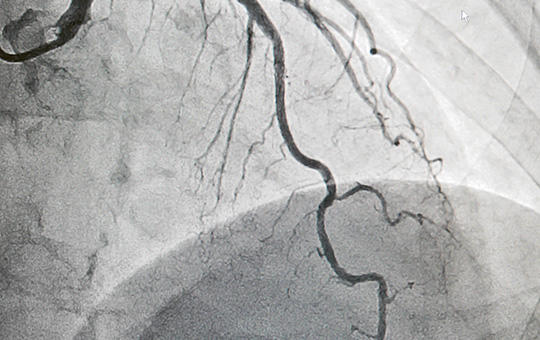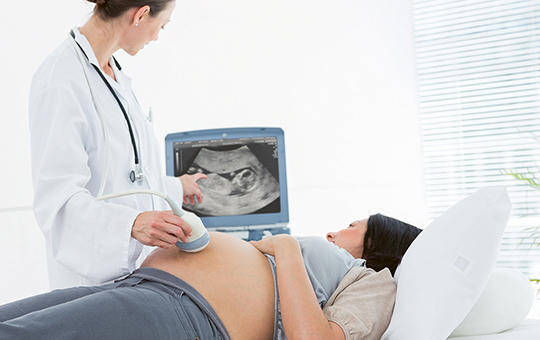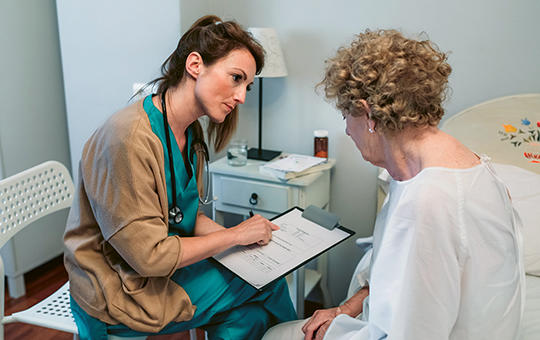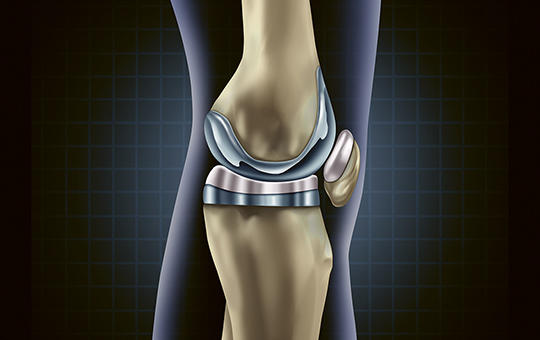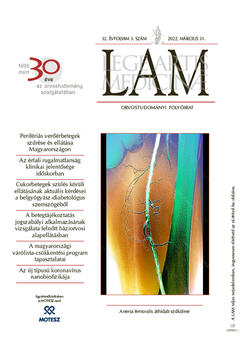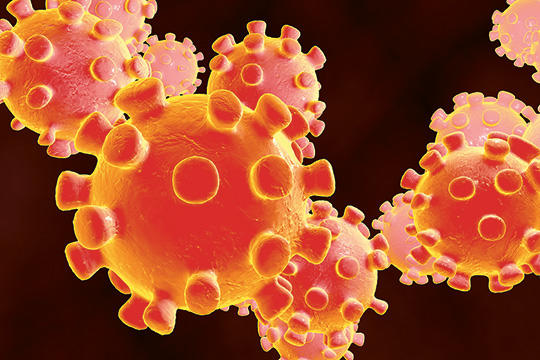The eLitMed.hu medical portal uses computer cookies for convenient operation. Detailed information can be found in the Cookie-policy.
Lege Artis Medicinae - 2022;32(03)
Content
[Screening and care of patients with lower extremity arterial disease in Hungary]
[Lower extremity arterial disease, in addition to the worsening life quality due to the concerning complaints and the rist of amputation, entails high risk of cardiovascular morbidity and mortality. The prevalence of this disease in the Hungarian population is close to 600 000 people, based on an extrapolation of the international epidemiological data. In the recent years two target studies started (i) to analyse the performance of screening for lower extremity arterial disease in a representative hypertensive population (ÉRV Program), and (ii) to analyse the data of patients in the whole Hungarian health insurance population with lower extremity amputation or revascularization (HUNVASCDATA study). The present review summarizes the outcomes of these two studies. Data analysis on national sample bears high importance, since any improvement in vascular care in Hungary rests entirely on this information. ]
[Clinical implication of arterial stiffness in the elderly]
[Hypertension prevalence and cardiovascular risk gradually with age. However this aging process seems to take a more rapid course in some individuals, as reflected in the Early Vascular Aging (EVA) syndrome. Age and high blood pressure are the two main determinants of arterial stiffness which is the core of EVA: the impaired elasticity of the media layer of large elastic arteries (mainly the aorta), a process that can be measured by pulse wave velocity. In elderly hypertensives, large arteries stiffen and systolic and pulse pressures increase, due to wave reflections. Arterial stiffness has predictive value for future CV e.g. events, coronary artery disease, stroke, and vascular dementia and even all-cause mortality. The concepts of EVA (Early Vascular Aging) and SUPERNOVA (Supernormal Vascular Aging, the opposite phenotype of EVA) help to understand why early target-organ damages develop in some individuals and why others remain much more “younger” than their chronologic age. New drugs are being developed to treat EVA when lifestyle intervention and conventional risk factor controlling drugs are not enough.]
[Current issues in the peripartum management of diabetic women from the perspective of an internist-diabetologist]
[In pregnancy complicated with diabetes, treatment of hyperglycaemia is of fundamental importance during delivery in order to improve the outcome parameters of both the mother and the neonate. This is particularly important in the case of mothers with type 1 diabetes and of all mothers who require insulin treatment during their pregnancy. The use of antenatal steroids for women at risk of pre-term birth further complicates the treatment of hyperglycaemia in the period immediately before delivery and requires the appropriate change of insulin therapy. The requirement of nil per os in the delivery period necessitates proper fluid, glucose and insulin treatment in the pre-delivery hours. After surgical delivery the patients may also need infusion treatment until the first meal. As there is no unified guideline for the peripartum management of diabetes, the author reviews the international literature on the internal medicine issues concerning the peripartum treatment of pregnant women with diabetes. This study reviews the characteristics of insulin treatment of women with various types of diabetes before, during and directly after delivery. It presents a dosing schedule for women who needed an antenatal steroid treatment in the period before delivery due to premature birth for the purpose of lung maturation. The study also addresses the application and programming of peripartum blood glucose tests, continuous interstitial glucose monitoring (CGM) and insulin pump treatment (CSII).]
[Exploring the legal implementation of patient information in adult general practice]
[Informing patients is still a concern for both patients and physicians. The §45/1 of the Act 1972 II. dealt the first time with general patient information. The right of patients to adequate information and the obligations of healthcare providers in order to enforce this right are enshrined in Articles 13 and §134-135 of the Act CLIV 1997 on Health. Under these laws, the patient is entitled to the full information provided to him/her in an individualized form. Regarding the content and scope of patient information, the main issue is its purpose. Thus the patient has to be placed in a position to assess the risk of the intervention and to make an informed decision about his/her own fate. A questionnaire-based survey, which included 42 questions in five blocks, was conducted on a sample of 547 adults. As demonstrated, there was a strong correlation between patients’ understanding of health and their need for information, and the content of doctor-patient interaction was not affected by how long the patient has been with his/her GP and the age of the doctor. The results showed that following the legal requirements for patient information and GP primary care during doctor-patient meetings is essential. It can be concluded that the number of individual doctor-patient appointments, their actual time and the number of patients appearing in the practice are not sufficient to ensure entirely the patient's general right to information.]
[Analysis of utilization and territorial distribution of Hungary’s waiting list reduction programme ]
[In Hungary, the systematic waiting-list reduction program (“X” financing code) started in 2015 aiming to significantly reduce the waiting times of most relevant waiting lists services. The aim of this study was to evaluate the utilization and the territorial distribution of cases financed under the “X-code” between 2015 and 2018. We designed a retrospective and quantitative research on data of the Hungarian National Health Insurance Fund. Relevant data contained all publicly financed X-code cases between 2015 and 2018. Since 2015, this code covered the financing of services related to the waiting list reduction program. Processed data informed about patients (age, sex, residency at county level), involved health care facilities (name, type and location among the counties) as well as all provided medical interventions. In the study period 27,716 cases (mean age 68.05 years) were financed, the majority of patients (63.1%) was female. Case numbers per 10,000 inhabitants were the highest in Counties Baranya (84.63), Somogy (60.17), and Zala (58.89). 71.6% of patients received primary care in their residence county. The most frequent intervention was cataract surgery. During Hungary’s waiting list reduction program high number of patients received medical services. We found significant inequalities in utilization of waiting lists interventions and in the institutional engagement.]
[Whether we teach effectively what we consider being important? As seen by medical educators]
[In Hungary the training and output requirements of faculty of general medicine determine the required knowledge, skills and abilities, i.e. competences of graduated medical doctors. On the one hand, we examined how the teachers ponder the weight of competences established for medical education in the training and output requirements, on the other hand to what extent they mediate these during their teaching activity. The field research by self-developed questionnaires was carried out in four Hungarian medical schools in the fall semester 2017. For evaluation we used gap analysis, Wilcoxon signed-rank test and factor analysis. The questionnaire was sent to all lecturers (n=1790) of the four medical schools and 439 of them filled it out (24.5%). Results of the research show that the lecturers do not mediate any competence in their teaching practice in such an extent, as important as they consider it is (except one). There are statistically proved negative gaps between the extent of importance and mediation – to a different extent per competence. The examined competences can be grouped in well identifiable factors, which corresponds to the three-circle model accepted in the international literature. Results of the research underline, that beside the core competences of medical knowledge, there are further developmental opportunities in the medical education, the importance of which was ensured by the lecturers as well. In addition to the realization of lacks and needs the development of lecturers’ skills as well as pedagogical and didactical knowledge are inevitable for the implementation. ]
[Nanobiophysics of new type coronavirus]
[The Covid-19 pandemic has swept across the world, causing a never seen burden on our health care systems and challenging biomedical research to give appropriate answers to the epidemic. Modern, one-particle biophysical methods ensure special insight to the characteristics of the cause of the epidemic, the SARS-CoV-2. The virus carries a crown-like layer of spike proteins, which plays a fundamental role in the process of infection. The topography structure and mechanical characteristics of native virions have been determined by atomic force microscopy. Spike proteins form a dynamic surface due to their flexibility and motility. Virions are surprisingly resistant to mechanical compression, and their structure is able to recover after mechanical perturbation. The global structure of the virus is resistant to heat effect, but spike proteins dissociate from the surface with higher temperatures. The mechanical and dynamic characteristics of SARS-CoV-2 contribute to its virulence. The applied one-particle biophysical methods play an important role in understanding and fighting with the more common virus infections. ]
1.
Clinical Neuroscience
[Headache registry in Szeged: Experiences regarding to migraine patients]2.
Clinical Neuroscience
[The new target population of stroke awareness campaign: Kindergarten students ]3.
Clinical Neuroscience
Is there any difference in mortality rates of atrial fibrillation detected before or after ischemic stroke?4.
Clinical Neuroscience
Factors influencing the level of stigma in Parkinson’s disease in western Turkey5.
Clinical Neuroscience
[The effects of demographic and clinical factors on the severity of poststroke aphasia]1.
2.
Clinical Oncology
[Pancreatic cancer: ESMO Clinical Practice Guideline for diagnosis, treatment and follow-up]3.
Clinical Oncology
[Pharmacovigilance landscape – Lessons from the past and opportunities for future]4.
5.




